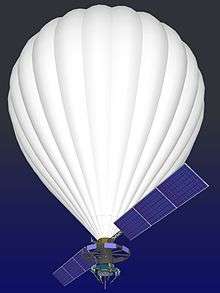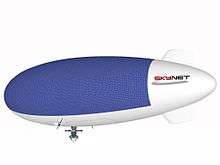Geostationary balloon satellite



Geostationary balloon satellites (GBS) are atmosphere analogues to satellites that float in the stratosphere (60,000 to 70,000 feet (18 to 21 km) above sea level) at a fixed point over the Earth's surface. At that altitude, air density is 1/10 of what it is at sea level. The average wind speed at these levels is less than that at the surface. A propulsion system would allow the balloon to move into and maintain its position. The GBS would be powered with solar panels en route to its location and then receive laser power from a cell tower it hovers over.
A GBS could be used to provide broadband Internet access over a large area. Laser broadband would connect the GBS to the network, which could then provide a large area of coverage because of its wider line of sight over the curvature of the Earth and unimpeded Fresnel zone.[2][3][4]
Arizona space balloon port
World View Enterprises has been approved to build a balloon spaceport (high-altitude balloon port) in Pima County, Arizona.[5]
See also
References
- ↑ Mark Prigg (August 26, 2014). "Could airships replace satellites? Nasa planning $4m contest". dailymail.co.u.
- ↑ "A low cost alternative for satellites- tethered ultra-high altitude balloons". ieeexplore.ieee.org. Retrieved 24 March 2014.
- ↑ The Use of Balloons for Physics and Astronomy. books.google.com.np. Retrieved 24 March 2014.
- ↑ "NOAA's Geostationary and Polar-Orbiting Weather Satellites". noaasis.noaa.gov. Retrieved 24 March 2014.
- ↑ Emily Calandrelli (January 19, 2016). "Arizona Votes To Build Spaceport For Space Ballooning".